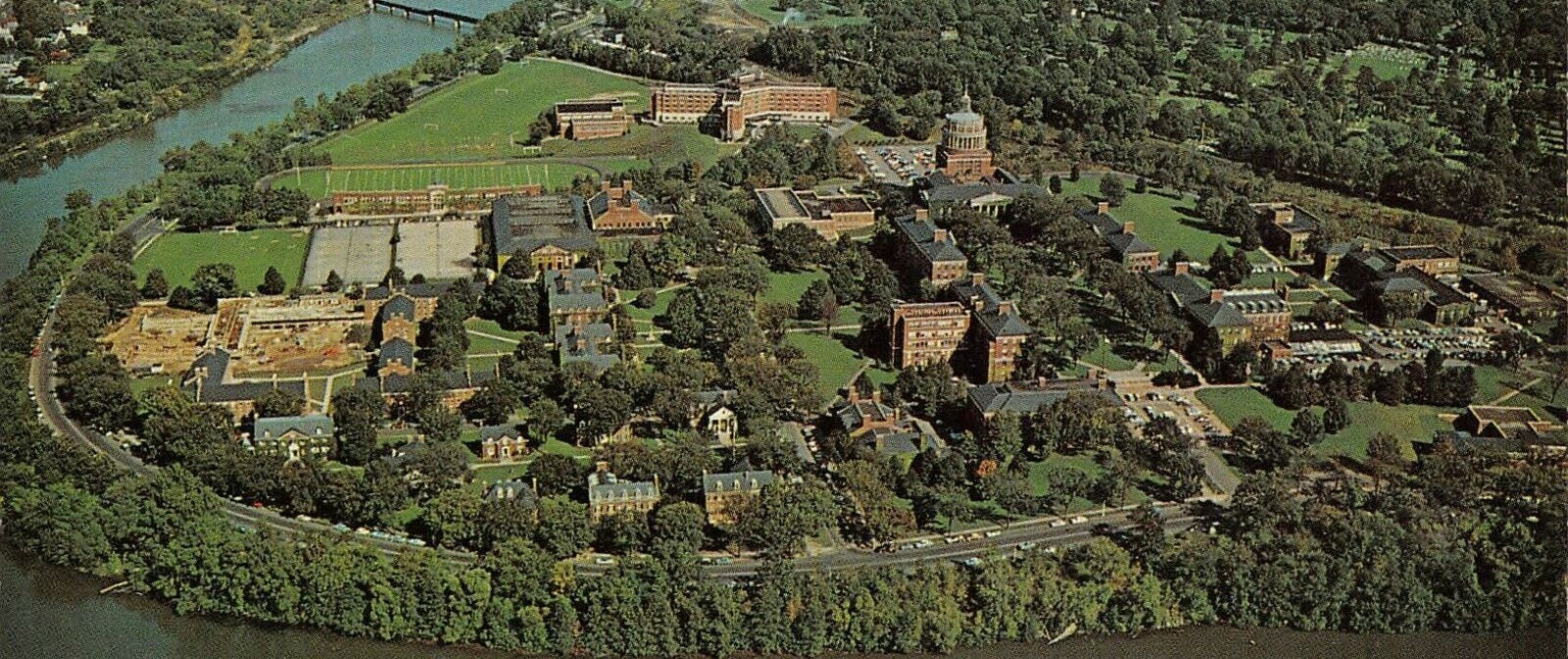
| River Campus |
 |
| 1958 Aerial Photo of the River Campus |
| Aerial
Photos of River Campus, note that some dates may be approximate |
||||||||||||||||||||||||||||
| 1923 | 1928 | 1930 | 1930 | 1930 | 1930s | 1931 | 1931 | 1935 | 1935 | 1948 | 1950 | 1950 | 1950 | 1951 | 1954 | 1955 | 1958 | 1959 | 1959 | 1962 | 1962 | 1962 | 1962 | |||||
| 1962 | 1962 | 1964 | 1964 | 1968 | 1977 | 1980 | 1992 | 1999 | 2003 | 2003 | 2004 | 2006 | 2007 | 2007 | 2008 | 2012 | 2015 | 2015 | 2016 | 2017 | 2018 | 2018 | 2018 | |||||
| These three
historical markers were designed by your correspondent in 2005 for
the new Bausch & Lomb Riverside Park. The markers are still in place, but are a bit weather-beaten. |
||
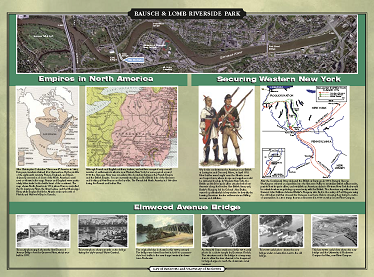 |
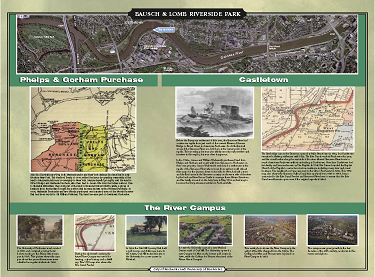 |
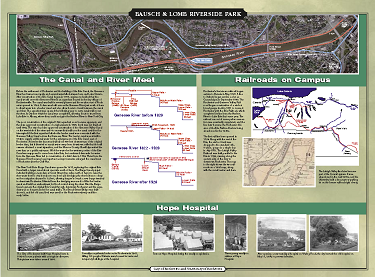 |
| Elmwood Avenue Bridge | Pedestrian Bridge at Genesee Rapids | Railroad Bridge |
| Maps of River
Campus from 1858 to 1935 (click on image for larger map) | Also
visit the City of Rochester's Historic
Map Viewer | |
||||||
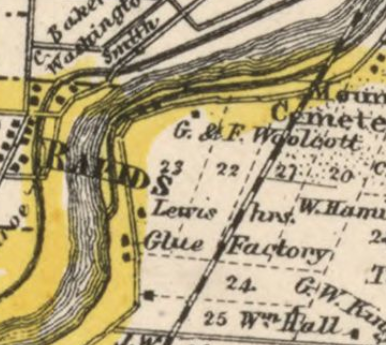 |
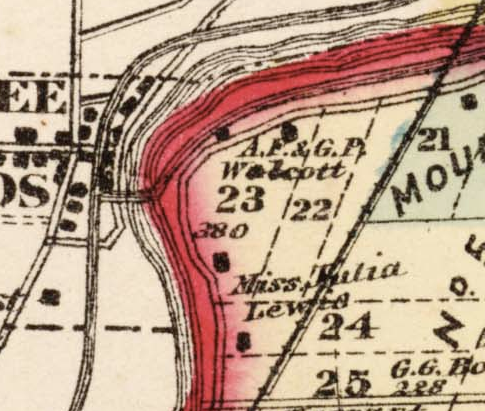 |
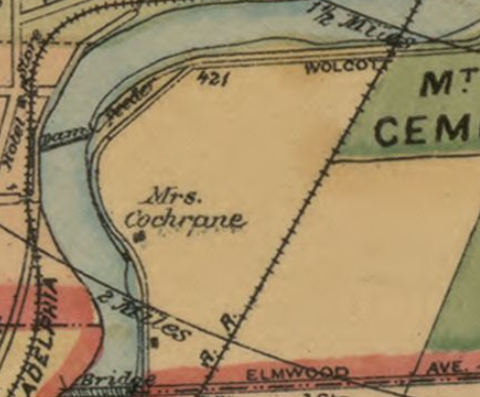 |
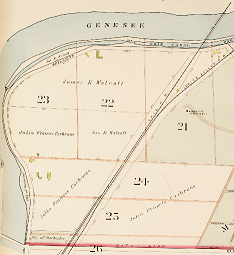 |
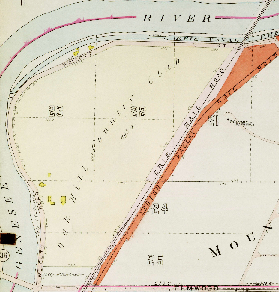 |
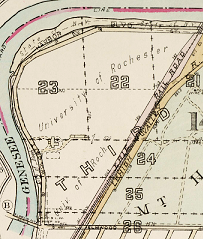 |
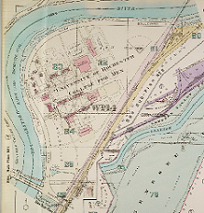 |
| 1858 |
1872 |
1887 |
1900 |
1910 |
1926 | 1935 |
The land that became River Campus was the site of an Algonquin Village around 1300 and adjacent to a ford across the Genesee River at a set of rapids near the present Pedestrian Bridge. A group of British troops known as Butler's Rangers, escaping from the Sullivan Expedition in 1779, intended to cross at the rapids, but the water was too high so they buried a cache of ammunition and traveled down to Lake Ontario. The cache was discovered by a farmer in 1816.
A dam was built across the river in 1822 to deliver water through a feeder canal for the new Erie Canal, which also allowed canal boats to travel between the river and canal. The feeder canal was abandoned after the new Barge Canal opened in 1918.
The land along the river became farmland and in 1827 Epaphras Wolcott set up a distillery next to Clarissa (now Ford) Street. When he died in 1852, Epaphras left his business to his sons, Anson and George, who in turn passed it on to Anson’s nephew James in 1880. Twenty years later James Wolcott retired and leased much of the family’s farmland south of the distillery to Oak Hill Country Club. The area was annexed by the City of Rochester in 1861 and 1874.
The Genesee Valley Canal opened on the west side of the river in 1838 and was abandoned in 1878. A new, higher dam was built to replace the 1822 dam to support the new canal, but it caused flooding upstream and was removed by the Monroe County Sheriff in 1842. The abandoned canal was sold to the Genesee Valley Canal Railroad, which opened in 1882 and later was leased by the Pennsylvania Railroad.
The Rochester &
Genesee Valley Railroad was built through the future campus in 1854 and
became part of the Erie
Railroad. This line crossed over to the west side of the
Genesee River on the north side of the future campus. The Lehigh
Valley Rail Road opened on September 1, 1892 and ran parallel to the Erie
through campus before splitting to go up the east side of the river to the
Lehigh
Valley Station (now Dinosaur Bar-B-Que). .The railroads by
campus were all abandoned and removed in the 1970s and 1980s, and the
former rail bed through campus was turned into a long, skinny parking lot.
The University bought a new site for the Oak Hill Country Club in 1922, allowing the College for Men to be moved from the Prince Street Campus to be adjacent to the University's new Medical Center. The University obtained possession of the River Campus property on March 1, 1926 and ground was broken for the new Chemistry Laboratory on May 21, 1927, the same day that Charles Lindbergh landed in Paris.
The road along the Genesee River was known as Wolcott Street, Harbor Boulevard, and River Boulevard before being named Wilson Boulevard after Joseph C. Wilson in 1972.
The College for Men moved to the new River Campus in October 1930. Additional land was purchased in 1962 and later.
Buildings | River
Campus Map (August 3, 2021) |
1930 | Rush Rhees Library | Morey
| Lattimore | Bausch &
Lomb | Dewey | Strong
Auditorium | Engineering (Gavett) | Todd
Union | Alumni Gym (Goergen Athletic Center)
| Stadium (Fauver) | Burton
| Crosby | Fraternities
|
1935 Service Building (Taylor Hall)
1946 | Harkness | Veterans' Dormitories |
1947 | Cyclotron | Gavett Annex |
1949 Lattimore Annex
1953 | East Dorm (Hoeing) | West Dorm (Lovejoy) |
1955 | Men's Dining Hall (Douglass Commons) | Women's Residence Center (Susan B. Anthony) | Women's Gymnasium (Spurrier) |
1956 Trevor Observatory
1957 Tiernan
1958 | Administration (Wallis) | Particle Physics (New York State Optics) | Cyclotron Laboratory Addition |
1959 Gilbert
1960 | Third Floor addition to Gavett Annex | Gilbert wings completed |
1961 Third Floor Addition to Administration Building Wing
1962 | Hoyt | Brain Research Center (Morey Annex) | Bausch & Lomb Annex | Third floor addition to Harkness | Two floors added to north side of Rush Rhees |
1963 | Hopeman | Founders Court (Jackson Court) | West Tower (Anderson) | East Tower (Wilder) | Towers Dining (Sage Arts Center) | Two floors added to Men's Dining Center |
1965 | Mees Observatory | Graduate Living Center (Southside; Valentine; deKiewiet) |
1968 Summer Theater
1969 | Space Science (Wilmot) | Hill Court (Chambers, Fairchild, Gale, Kendrick, Munro, and Slater Houses) | Dewey Annex |
1970 Interfaith Chapel
1971 Mathematical Sciences (Hylan)
1972 Hutchison
1974 Psychology (Meliora)
1976 Wilson Commons
1982 Zornow Field House
1984 Maintenance-Transportation Facility (Public Safety).
1985 Meliora Hall overhang infill
1987 Computer Studies & Science Library
1991 Schlegel
2001 Gleason
2007 Goergen
2008 | University Health Service | Riverview Apartments |
2012 O'Brien
2014 Brooks Crossing Apartments
2015 Riverview Apartments Building G
2016 Wegmans
2017 Genesee
2020 Fourth floor addition to University Health Service
2021 Sloan
Performing Arts Center
References
| Also see History of Campus Technology
and History
of Rochester |
1838 Genesee Valley Canal opens on the west side of the river.
1853 Deed from Anson F. Wolcott to the Rochester & Genesee Valley Railroad Company, May 12, 1853, $2,592, book 109, page 244.
1853 Deed from Simeon Lewis to the Rochester & Genesee Valley Railroad Company, October 8, 1853, $2,000, book 114, page 175.
1854 Rochester merchants fear a NYC monopoly, and a connection with another railroad is desired. The Rochester & Genesee Valley Railroad is built south to Avon to connect with the Erie. The line south of Rochester is built to 6-foot gauge to interchange with the Erie. This line was essentially always under Erie control. (future Erie line into Rochester)
1855 Deed from Anson F. Wolcott et al. to the Rochester & Genesee Valley Railroad Company, December 3, 1855, $272, book 128, page 422.
1871 Deed
from State of New York Anson F. Wolcott, November 23, 1871, book
251, page 87.
Land from old feeder canal.
1882 The Genesee Valley Canal railroad was built along the abandoned Genesee Valley Canal. (later Pennsylvania Rail Road)
1884 Semi-centennial
History of the City of Rochester, by William Farley Peck
Page 42: In their anxiety to distance Sullivan’s soldiers, Butler’s
men rid themselves of everything possible at this ford. Ammunition and
arms were buried in the ground near the springs and concealed in hollow
trees in the vicinity. In 1816 Mr. Boughton found ninety-six pounds of
bullets in the bottom of a rotten stump, and several other discoveries of
bullets, bars of lead, etc., have been made by various parties.
1884 Map of Indian Trails about Rochester, as described by George H. Harris
1884 Semi-centennial
History of the City of Rochester: With Illustrations and Biographical
Sketches of Some of Its Prominent Men and Pioneers, by William
Farley Peck
Pages 2-96: "Aboriginal occupation of the lower Genesee country," by
George H. Harris. | also published
separately |
Page 42: At the rapids in South Rochester the river passes over a
ledge of limestone, and before the dam was constructed the channel was
very shallow some sixty rods above and below. On the east bank a flat
extended from Red creek north around the base of Oak hill. It was eaten
away by the current long years ago, but it originally constituted the the
east-side landing of the ford. The west end of Elmwood avenue strikes the
river just south of the upper edge of the old ford. In early pioneer days
there were two or three good springs in the bank of a small creek which
entered the river at that point. A prehistoric town, covering all the
surface of Oak hill, once existed there. Stone relics were found on every
foot of the ground from the feeder dam to Red creek, by the early
settlers. In their anxiety to distance Sullivan's soldiers, Butler's men
rid themselves of everything possible at this ford. Ammunition and arms
were buried in the ground near the springs and concealed in hollow trees
in the vicinity. In 1816 Mr. Boughton found ninety-six pounds of bullets
in the bottom of a rotten stump, and several other discoveries of bullets,
bars of lead, etc., have been made by various parties.
1890 "Honeoye
Falls Railway," Democrat and Chronicle, May 22, 1890, Page
1.
Permission to Occupy the Feeder Bank Affirmed.
1891 Deed from the City of Rochester to the Rochester and Honeoye Valley Railroad Company, October 28, 1891, $6,000, page 487, book 236.
1891 The Lehigh Valley Railroad built its new mainline to Buffalo across the landscape south of Rochester. The last of the 20th Century Class-1s to enter the region. the LV's Rochester branch, which left the mainline at Rochester Junction to enter the city from the south, officially opens on September 1, 1892.
1892 Sanborn Fire Insurance Map from Rochester, Monroe County, New York. Volume 1 | Volume 2 | Volume 3 |
1901 "The
Oak Hill Country Club," Democrat and Chronicle, October 2,
1901, Page 7.
Rochester has another organization of men for outdoor amusement. The
Oak Hill Country Club was organized last night with 125 names of charter
members attached to its roster.
1901 Lease
from James E. Wolcott to the Oak Hill Country Club, October 9, 1901,
$600 yearly, book 648, page 82.
About 50 acres, term of ten years from April 1, 1902 to March 31, 1912,
1901 Lease
from Joseph A. Adlington to the Oak Hill Country Club, October 9,
1901, $600 yearly, book 648, page 85.
About 55 acres, term of five years from April 1, 1902 to March 31, 1907.
1902 Site
of Hope Hospital
The site of Hope Hospital, a temporary hospital for smallpox patients, on
the east bank of the Genesee River. In the center are some Lehigh Valley
Railroad tracks. To the left is the Erie Railroad bridge across the
river. The University's Public Safety Building now occupies this
site.
1906 Deed from Ida J. Wolcott to Oak Hill Country Club, June 22, 1906, $1.00, book 735, page 437
1906 Deed from Joseph A. Adlington to the Oak Hill Country Club, June 28, 1906, $13,880, book 735, page 439.
1917 "Golfers
of Oak Hill Club Win by Big Margin," Democrat and Chronicle,
June 17, 1917, Page 37
It is well-known that Oak Hill boasts of a sporty course and the visitors
found some of the holes difficult to negotiate, especially Gibraltar Hill.
1920 "University
to Have Its Own Auditorium," Democrat and Chronicle,
December 15, 1920, Page 25.
Mrs. Henry A. Strong Gives $200,000 for Purpose.
1921 "Greater University on New Site Proposed," Democrat and Chronicle, February 10, 1921, Page 1 | Part 2 |
1921 "Oak
Hill Site Is Approved by University Trustees," Democrat and
Chronicle, November 6, 1921, Page 1. | Part
2 |
Present Plan Would Place College For Men on Country Club Site and Medical
School on Elmwood Avenue.
1922 "Members
of Oak Hill Club Approve Plan for Providing Them with New Golf Course,"
Democrat and Chronicle, January 24, 1922, Page 16.
University to Take Present Club Property and Pay for New Links and
Buildings.
1922 "Room for Two Eighteen-hole Golf Courses on New Site of Oak Hill Club; One Links Ready in 1924," Democrat and Chronicle, May 6, 1922, Page 21.
1923 "The
Pinnacle Hills or The Rochester Kame-Moraine," by Herman L.
Fairchild, Proceedings of the Rochester Academy of Sciences
6(5):141-194 (November 1923)
Page 186: OAK HILL; UNIVERSITY OF ROCHESTER SITE
This area is the westward extension of the ridge 111 the west side of Mt.
Hope Cemetery. The cut for the railroads makes the artificial division.
The area lies in a meander or sharp westward bend of the Genesee River,
which is the reflex of the eastward meander in Genesee Valley Parle
Doubtless the moraine extended as a continuous ridge westward from the
cemetery kames to and along Brooks Avenue, west of the river. The river
has breached the moraine, and the Oak Hill area lies between the
artificial railroad cut and the natural river trench.
The surface of Oak Hill has been somewhat smoothed, for the golf ground
and the drives, but it yet shows the rolling morainal surface. The
altitude is somewhat under the cemetery ridge. The highest point is close
to the railroad cut, being 584 feet. The central ridge has elevation by
the railroad cut of 580 feet, declining westward to 565 feet at the Club
House.
1923 Aerial Views of River Campus
1924 "Oak Hill To Transfer Site to University Immediately: Club Votes to Accept Plan," Democrat and Chronicle, April 5, 1924, Page 1.
1924 "Big Alumni Day at Oak Hill This June," Rochester Review 2(4):73-24 (April-May 1924)
1924 "Greater University Drive Hailed as Important Step in Onward March of City," Democrat and Chronicle, September 16, 1924, Page 23.
1924 "Six Million in Sight for U. of R.," Democrat and Chronicle, November 15, 1924, Page 1.
1924 "First Reports in University Drive to be made To-Day," Democrat and Chronicle, November 17, 1924, Page 20.
1924 "University Fund Needs $1,100,000," Democrat and Chronicle, November 23, 1924, Page 1.
1924 "Rochester Gives $7,500,007.41 for U. of R. $10,000,000 Fund," Democrat and Chronicle, November 25, 1924, Page 1. | Part 2 | Part 3 |
1925 "How Old Is Oak Hill?" by Herman Leroy Fairchild, Rochester Review 4(2):34-37 (December 1925-January 1926)
1926 Petition and Order allowing Oak Hill Country Club to sell their land to the University of Rochester, March 2, 1926, book 1347, page 218
1926 Deed from Oak Hill Country Club to the University of Rochester, February 20, 1926, book 1353, page 169.
1926 "Deed to New Oak Hill Country Club Property Recorded," Democrat and Chronicle, March 7, 1926, Page 30.
1926 "Plans
for Oak Hill Announced," Campus Times, December 17, 1926,
Page 1.
Note the railroad line running to Gavett Hall.
1927
"Break
Ground on Oak Hill Campus," The Campus, May 20, 1927, Page
4.
Ground will be broken tomorrow morning at the University's Oak Hill site
for the chemistry building.
1927 "Flames Destroy Old Oak Hill Club Building Owned by University; Valuable Documents, Fossils Saved," Democrat and Chronicle, September 25, 1927, Page 1.
1927 Rochester,
the making of a university, by Jesse Leonard Rosenberger, with
an introduction by President Rush Rhees.
Facing page 274: Rendering of main
quadrangle of new College for Men.
Page 312: Possession of the new site for the College for Men was
obtained from the Oak Hill Country Club on March 1, 1926.
1928 "Cherished Traditions of the Past to be Preserved on New College Campus," Rochester Review 6(4):99-101 (April-May 1928)
1928 "Panoramic View of Main Quadrangle on New Campus of College for Men as it Appeared on October 25," Rochester Review 7(1):2 (October-November 1928)
1929 "New Campus for Men Rapidly Taking Form," Rochester Review 8(1):3-7 (October-November 1929)
1929 "Passing
of Old Council Kills Bills," Democrat and Chronicle,
December 31, 1929, Page 13.
River Boulevard new name given to Wolcott Road
1929 The University of Rochester; its honored past and expanding future | pdf |
1930 "Erection of New University Plant Engineering Marvel," Democrat and Chronicle, October 12, 1930, Page 1C. | Part 2 | Part 3 |
1930 The University of Rochester: A Story of Expansion and Its Background, by Hugh A. Smith.
1930 Dedication of the new buildings of the College for Men, the University of Rochester, River Campus, October 10th, 11th and 12th, 1930, Rochester, New York.
1930 Program of Dedication: New Buildings of the College for Men, the University of Rochester, October Tenth, Eleventh Twelfth 1930, Rochester, New York.
1930 The Schiff Photographs of the River Campus
1931 "The First Human
Occupation of the Rochester Region," Arthur C. Parker, Rochester
Historical Society Publication, 10:19-48 (1931)
Earliest known reference identifying Algonkins (or Algonquins) as the
occupants of Oak Hill.
1931 "The University of Rochester," by Rush Rhees, The Phi Beta Kappa Key 7(12):764-768 (May 1931)
1932 "The Algonkin Sequence in New York," by William A. Ritchie, American Anthropologist, N.S. 34(3):406-414 (July-September 1932)
1936 The University of Rochester College for Men, Rochester, N.Y.
1937 "'Beside
the Genesee' in 1669," by Alexander M. Stewart, Rochester Review
15(4):11-12 (June-July 1937)
Robert Cavalier de la Salle and Rene Gelinee's probable visit to Oak Hill
in 1669.
1937 "Campus Once Glue Factory Site," Rochester Review 16(2):10-11 (December 1937 - January 1938)
1938 "Cornfed Indians Liked Oak Hill," by George D. Selden, Rochester Review 16(4):10-12 (April-May 1938)
1940 "River Campus Delighted Pioneers Who Settled There 125 Years Ago," Rochester Review 19(2):20 (December 1940 - January 1941)
1941 "Erie
to Quit Service Today," Democrat and Chronicle, September
30, 1941, Page 13.
Eighty-seven years of Erie Railroad passenger service for Rochester will
come to an end at 6:15 p.m. today when the last train leaves the Court
Street Station for Avon. But increased freight business in and out of
Rochester means a virtual rejuvenation of the line, which once had
frequent passenger service to points south of the city in the Genesee
Valley.
All the Rochester personnel of the passenger department is being absorbed
by the freight agency because of heavy shipping, James H. Hagans, local
representative of the Erie, pointed out. The Erie received permission from
the Public Service Commission to abandon its Avon-Rochester passenger
service because of poor financial return. In turn, the PSC authorized the
Valley Bus Lines to operate a bus line via West Henrietta Road into Avon.
The line seeks to change its route to the East River Road, which parallels
the Erie’s tracks, along a great part of the way to Avon.
1947 "City
Spurs Bridge Plan at River Bl.," Democrat and Chronicle,
August 13, 1947, Page 4B.
Straightening of River Boulevard at the Lehigh Valley-Erie Railroad
bridges
1947 The College for Men of the University of Rochester.
1950 "Pros and Cons of Five-Day Week Featured at Assembly Wednesday," Tower Times, March 3, 1950, Page 2.
1950 - September, Lehigh Valley RR ends doodlebug passenger service out of Rochester. But LV passengers can still take a Valley Lines bus between the LV Rochester station and Rochester Junction until 1957, and taxi service until the final run of the Black Diamond on May 12, 1959.
1950 "Lehigh
Train Rolls Away, for Good," Democrat and Chronicle,
September 7, 1950.
Buses to Operate from Rochester to Main Line Today
1951 "New Span Eliminates S-Curve on River Blvd.," Democrat and Chronicle, July 20, 1951, Page 21.
1952 "Women's, Men's Colleges To be Merged on River Campus," Rochester Review 13(3):5-8 (May 1952)
1953 "Improved
Dormitory System Sparks River Campus Scene," by Artie Bernhang, Campus
Times, September 25, 1953, Page 1. | part
2 |
A new telephone system is in the process of being installed. It will work
from central switchboard in East dormitory. All incoming phone calls will
be received there, and then by means of the two-way speaker system
installed in the dorms, the party will be called to a convenient house
phone, one on each floor. Out going calls will be made by means of pay
phones in the dorms.
1953 With an eye toward us : the University of Rochester
1953 Creative Change – for the University Rochester and the Community, Text by Andrew D. Wolf, Photography by Ansel Adams.
1954 The merger story: a story of vision, by Eugene Willard Dennis and John Rothwell Slater
1955 "UR to move 10-ton statue of its 1st president today," Democrat and Chronicle, July 25, 1955, Page 18.
1955 "Women's
College Moving Completed This Week," Democrat and Chronicle,
September 9, 1955, Page 22.
The bursar's office in charge of Robert F. Moser will also remain at
Prince Street until the new Supplies and Accounts building in Elmwood
Avenue at the Medical Center is completed in the fall.
1955 "University Completes Huge Moving Project," Campus Times, September 20, 1955, Page 1.
1955 "UR River Campus is 25 Years Old," Democrat and Chronicle, October 9, 1955, Page 3B.
1955 "A Hill Steeped in History, Lore," by Arch Merrill, Democrat and Chronicle, October 30, 1955, Page 14E
1957 "Education's
Growth Pattern," Democrat and Chronicle, July 10, 1957, Page
15.
Aerial photo of new buildings in the last four years.
1958 "Campus
Space Problem," Democrat and Chronicle, November 23, 1958,
Page 29.
Aerial photo of entire campus
1959 "Famed
Train Ends Its Runs," Democrat and Chronicle, May 12, 1959.
The last Black Diamond to travel east passed through Rochester Junction at
9:46 a.m. yesterday.
1959 "UR to Seek Nearly 50 Million To Meet Long-Term 'Challenge'," Democrat and Chronicle, September 22, 1959, Page 1.
1960 "Conference Weighs County-Owned Land for UR Expansion," Democrat and Chronicle, February 5, 1960, Page 1.
1960 "Old Plans for River Campus Make UR a Garden Paradise," Campus Times, March 8, 1960, Page 2.
1961 "Plans for New Route 15 Will Take Part of Park," Democrat and Chronicle, February 8, 1961, Page 8. | Part 2 |
1961 "Outer Loop Arc to Parallel Barge Canal," Democrat and Chronicle, February 8, 1961, Page 17.
1961 "UR Students Protest Double-Up Dorm Plan," Democrat and Chronicle, March 1, 1961, Page 17.
1961 "Plans
for New Route 15 Will Take Part of Park," Democrat and Chronicle,
May 18, 1961, page 1 | Part
2 |
New road would run along present Intercampus Drive.
1961 "U.
of R. Plans Building on Football Field," Democrat and Chronicle,
October 12, 1961, Page 18.
The building would house biology and psychology departments and the Center
for Brain Research.
1961 "Greater University Programs Answers Expansion Demands," Campus Times, October 31, 1961, Page 1. | Part 2 |
1961 "Exiled
Co-eds Discuss Plight, Await Construction of Dorm," Campus Times,
December 15, 1961, Page 3.
Twenty-two River Campus women will have to live at the nurses' residence,
Helen Wood Hall.
1962 "Thompson Surveys Progress of Increased Construction," Campus Times, April 24, 1962, Page 11. | Part 2 |
1962 "$3 million in Facilities to be Opened by UR," Democrat and Chronicle, September 7, 1962, Page 17.
1962 "New Constructions Flourish on River Campus Grounds," Campus Times, September 25, 1962, Page 2.
1962 "Architect Speaks at Cabinet," Campus Times, November 9, 1962, Page 1. | Part 2 |
1964 "D&C Cites UR Involvement in Alleged Land Exchange," Campus Times, April 7, 1964, Page 1. | Part 2 |
1964 Not
beyond reach : the story of how Rochesterians helped solve the problem
of housing for senior citizens, [by Rochester Management]
Plymouth Gardens apartments, built in 1963 across the river from the UR
River Campus.
1965 "City Acts to Sell Land to Add to UR Campus," Democrat and Chronicle, January 27, 1965, Page 1B. | Part 2 |
1965 "UR
Only Bidder for City Land," Democrat and Chronicle, February
9, 1965, Page 11.
$150,000 for 16.3 acres.
1965 Deed
from the City of Rochester to the University of Rochester, April 29,
1965, $150,000, book 3636, page 535.
16.285 acres.
1965 "UR
Officially Asks to Buy Acreage in Genesee Park," Campus Times,
March 9, 1965, Page 1
Includes map of existing and proposed property
1965 "City, UR Study Plan for Exchange of Land," Democrat and Chronicle, March 9, 1965, Page 13.
1965 "Council
Favors Park Land Sale to U. of R.," Democrat and Chronicle,
March 12, 1965, Page 1B.
45 acres of the city's Genesee Valley Park
1965 "$80 Million Expansion Projected by U. of R.," Democrat and Chronicle, April 30, 1965, Page 1. | Part 2 |
1965 "Ten-Year Plan Promises Greater University," Campus Times, April 30, 1965, Page 3. | Part 2 |
1965 "4.28
Acres Sold to UR by City," Democrat and Chronicle, September
9, 1965, Page 18.
The land extends north from the Erie Railroad trestle along the east side
of the boulevard.
1965 Deed
from the City of Rochester to the University of Rochester, October
21, 1965, $64,200, book 3687, page 241.
4.280 acres.
1966 "Tomorrow
On The Campus," Democrat and Chronicle, September 25, 1966,
Page 1M. | Part
2 |
Addition to Rush Rhees Library and New Campus Center
1967 "Colleges
Cram for Big Expansions," Democrat and Chronicle, January
22, 1967, Page 8S.
Projects Completed during 1966 at the U. of R. included the nuclear
structure laboratory, $1.7 million; a University Medical Center addition
for the department of radiation biology and biophysics, $2.8 million. In
progress were a medical center wing containing research facilities and
quarters for animals used in research, $4.5 million; a modernization and
expansion of the heating plant, $5 million. Both are scheduled for
completion this year. Planned to start this year are: expansion of Rush
Rhees Library with a new wing, $6.4 million; six-floor space science
center, $1.5 million; six four-story undergraduate dormitories, $4.4
million; a chemistry-biology building, $11.5 million; six-story education
wing at the medical center, $10 million; temporary expansion of emergency
department at Strong Memorial Hospital, $500,000.
1968 "Oak
Hill Becomes the River Campus," by Arthur J. May, Rochester
History 30(1):1-24 (January 1968)
Page 10: In 1901, the Oak Hill Country Club of Rochester leased most
of the Aldington and Wolcott farmlands, laid out golf links, and five
years later bought the properties. A large farmhouse on the grounds served
as club quarters until replaced by a more commodious structure
situated at the western extremity of the present Eastman Quadrangle. As
has been related, the club conveyed the property to the University of
Rochester and moved off in 1926.
1968 "Account for a University's Uneven Growth," Campus Times, September 24, 1968, Page 3.
1968 "UR
Seeks $25 Million for Buildings," Democrat and Chronicle,
September 25, 1968, Page B1.
Drive over Top but U.S. Funds Cut
1969 "Campus Construction Projects Take Shape," Campus Times, September 26, 1969, Page 3.
1969 Deed from the Rochester and Genesee Valley Railroad to the University of Rochester, 1969, book 4029, page 499.
1969 Deed
from the City of Rochester to the University of Rochester, December
29, 1969, $2,642, book 4032, page 73.
1.585 acres and 1.057 acres.
1970 "The History of the University of Rochester Libraries," by Catherine D. Hayes, The University of Rochester Library Bulletin 25(3):59-122 (Spring 1970) | also here |
1970 "Construction Strike Forces Delays, Drastic Revisions in Planned UR Buildings," Campus Times, September 25, 1970, Page 1.
1970 - October 7, Erie Lackawanna begins using Lehigh Valley between Mortimer Junction to Erie/LV interchange just north of UofR. Erie tracks between Mortimer and this point soon removed.
1970 "Thompson Announces Revised Construction Schedule for Major Building and Renovation Projects," Currents, October 15, 1970.
1970 "UR
Plans 'Rail' Road," Democrat and Chronicle, November 20,
1970, page 22
The University of Rochester is planning to build a road nearly two miles
long along an Erie-Lackawanna Railroad track to connect three of its
campuses. The two-lane private road would run north from Crittenden Road
almost to River Boulevard at the River Campus. No date has been set for
construction, said George M. Angle, vice president for business affairs,
but removal of the railroad track was completed last week. Erie-Lackawanna
trains have been using the adjacent Lehigh Valley Railroad track for the
past month, in accordance with an agreement made between the two railroads
and the university in August 1969. The road probably will be
completed in several phases. The first phase may connect the Medical
School campus with the River Campus. Eventually the South Campus, which
now consists of the Nuclear Structure Laboratory on East River Road and
vacant university land, also will be connected. A parking lot, using the
railroad right-of-way where it adjoins River Campus, may precede the road
if funds are available, Angle said.
1971 - PRR Rochester branch removed between downtown and the Erie interchange.
1972 City ordinance changing the name of River Boulevard to Joseph C. Wilson Boulevard, January 7, 1972
1972 "Legal
Notice Trustees of the property of Lehigh Valley Railroad Company,"
Democrat and Chronicle, May 31, 1972, page 24
Abandonment of line from River Junction to the end of the end of the line
at the Rochester Subway.
1972 - Lehigh Valley abandoned between downtown terminus and UofR. (River Junction, between Erie & LV, alongside UofR)
1972 "Char-isma
and the Untouchables," Democrat and Chronicle, July 6, 1972,
page 16
The Lehigh Valley railroad has said that it will abandon about one mile of
track leading into the site of the former freight house on July 14,
Lorsong said. After that date, he said, trains will run only as far as the
University of Rochester and Erie-Lackawanna Railroad interchange near the
university.
1973 "UR to Consolidate Offices," Campus Times, February 14, 1973, Page 9
1973 "Rail Right-of-Way -- $1," Democrat and Chronicle, April 25, 1973 page 27
1975 "UR May Raze Morey Annex This Summer," Campus Times, April 15, 1975, Page 1. | Page 2 |
1975 Supplemental
Report to the Final System Plan for Restructuring Railroads in the
Northeast and Midwest Region Pursuant to the Regional Rail
Reorganization Act of 1973, July 26, 1975.
Pages 282-283: Rochester Branch, USRA Line No. 1000, Lehigh Valley
The Rochester Branch extends from Rochester Junction (Milepost 379.5) to
Rochester, N.Y. (Milepost 390.8), a distance of 11.3 miles
The line is essential to the University of Rochester which depends upon
deep-mined coal from West Virginia to heat its campus and its hospital. If
the University had to truck its coal it would cost an extra $3.50 per ton
and would result in 2,358 truckloads moving over local streets and
highways.
Reported Traffic Carloads, University of Rochester 1973 - 462; 1974 - 468;
1975 - 602; 1976 - 786.
1975 "Annex Destruction Delayed," Campus Times, September 12, 1975, Page 1.
1975 "UR builds riverside path for bicyclists, pedestrians," Campus Times, September 16, 1975, Page 1.
1975 "Notice
of Discontinuance of Rail Service," Democrat and Chronicle,
December 10, 1975, page 16
Lehigh Valley Railway Company and Rochester and Genesee Valley Railroad
Company, between Avon and Mortimer, and Lehigh Valley Railway between
Crittenden Road and River Junction.
1976 Conrail was formed on April 1, 1976, taking over the Lehigh Valley and Erie-Lackawanna railroads.
1977 From Little Acorns: The Story of Oak Hill, 1901-1976 -- The Seventy-Five Year Account of the History of Oak Hill Country Club, Rochester, New York, by Howard C. Hosmer
1977 History of the University of Rochester, 1850-1962, by Arthur J. May. Expanded edition with notes
1980 "New Home for Old Sculptures," Democrat and Chronicle, September 15, 1980, Page 1C. | part 2 |
1980 “Four restored statues unveiled,” Campus Times, October 7, 1980, Page 8. .
1980 "The Great 'Removal Project' Part I: Decision," by Betsy Brayer," Rochester Review 43(1):1-7 (Fall 1980)
1980 "A Suitable and Worthy Architecture," by Jean R. France," Rochester Review 43(1):8-9 (Fall 1980)
1980 "The Great 'Removal Project' Part II: A Dream Attained," by Betsy Brayer," Rochester Review 43(2):10-15 (Winter 1980-81)
1981 "Conrail
to abandon 47 miles of line including route for coal to RG&E," Democrat
and Chronicle, October 9, 1981, Page 18.
The Rochester North branch of the former Lehigh Valley line, an 11.3 mile
line that runs from the UR campus to Rochester Junction, just north of
Honeoye Falls.
1982 "College
Pranks - 'the way everybody uses to cope'," Democrat and
Chronicle, April 4, 1982, Page 1B. | Part
2 |
Freshman’s Guide to College Pranks, written by 1982 classmates Greg
Seminara and Brad Wolfson. The guide, which sells for $2, is a
two-page list of suggestions on how to wire a doorknob to shock the first
person who touches it, short sheet a bed or hurl snowballs 150 yards.
1982 "The Search for Rochester's Earliest Inhabitants: On the Trail with George Harris, the Pathfinder," by William T. Davis, Rochester History 44(1 & 2):1-44 (January and April 1982)
1982 "The Future of the University's Residence Halls," by Donald G. Hess, Campus Times, December 3, 1982, Page 8A
1982 - Conrail abandons the former Erie between River Junction (UofR) and downtown.
1983 "UR assures groups development plan is nothing to fear," Democrat and Chronicle, December 31, 1983, Page 1B. | Part 2 |
1984 "4
Miles of Rail Line Now Being Torn Up," Democrat and Chronicle,
February 17, 1984, Page 9.
Former Pennsylvania Railroad line on west side of river from Troup-Howell
Bridge to near Elmwood Avenue.
1984 "City
to buy 40 acres by river from Conrail," Democrat and Chronicle,
September 15, 1984, Page 1B. | Part
2 |
9 acres of major acquisition to be added to Genesee Park. Included
in the transaction is a railroad bridge across the river near the foot of
Magnolia Street and a continuation of the bridge that crosses Wilson
Boulevard and extends into the University of Rochester's River Campus.
1984 "Senate hears proposals for UR building plans," Campus Times, October 30, 1984, Page 2.
1984 "Residents
want a say on river plans," Democrat and Chronicle, December
2, 1984, Page 6. | part
2 |
South River Corridor Plan
1985 Lehigh Valley torn up between River Junction (U of R) and Mortimer Junction. Was in use into the 80's by Conrail to supply coal to the UofR/Strong Hospital powerplant.
1986 "UR
reaches for the top with 5-year plan," Democrat and Chronicle,
April 19, 1986, Page 1. | Part
2 | Part
3 |
UR to remain the UR, cheering students told.
1986 Deed from Conrail to
the University of Rochester, May 15, 1986, $330,000, book 6903, page 266
Mortimer to Rochester Junction (MP 290.1)
1986 "450 parking spaces
to be added," Currents, August 8, 1986, page 1.
To achieve this, the University recently purchased the former Conrail
right-of-way adjacent to Intercampus Drive. A total of 400 parking spaces
will be constructed between parking area Z on the north end of the River
Campus and the Central Utilities Plant to the south. At the same time,
another 50 spaces will be added at the south part of parking area Z.
1986 "Down by the Riverside," Rochester Review 49(1):24-25 (Fall 1986)
1987 Refurbished ice rink opened in Genesee Valley Park, a joint project of the city and University.
1990 "Construction
Projects reshape UR," Campus Times, September 23, 1990, Page
1. | Part
2 |
New buildings and a park will be constructed.
1995 "UR, city to collaborate on 'College Town' across river," Campus Times, Summer Edition 1995, Page 1.
2000 "UR Dedicates Dandelion Square," Democrat and Chronicle, September 9, 2000, Page 1B
2002 "UR
plans to rebuild Wilson Boulevard," Democrat and Chronicle,
April 13, 3002, Page 5B.
School hopes reopening road will boost public access to Riverside Park.
2002 "Notice
of Public Hearing Town of Brighton," Democrat and Chronicle,
November 28, 2002, page 65
The Town of Brighton bought the former railroad right of way between the
Erie Canal and Brighton-Henrietta Town Line Road. The University
reserved the right to install pipes and wires on the land.
2004 "All on-campus dorms become smoke free," Campus Times, September 9, 2004, Page 3
2005 Planning the New Campus, Curated by Nancy Martin
2009 George Eastman Tribute (video)
2011 Garden Party Address: The University and Our Community, June 6, 2011
2011 "Guess who? Unravel the mystery behind the names that mark our campus' buildings," by Julia Sklar, Campus Times, September 8, 2011
2011 Chemistry
2012 "From the Archives: Class reunion leads to statue restoration," by Kevin Scantlen, Campus Times April 26, 2012, Pages 11, 13.
2013 "Local
crops fueled distillery," by Emily Morry, Democrat and Chronicle,
May 6, 2013, Page B3 | Part
2 |
In 1827, Epaphras Wolcott, whose name once honored the riverside route now
taken by Wilson Boulevard, set up a distillery on the northernmost section
of his land. When he died in 1852, Epaphras left his business to his sons,
Anson and George, who in turn passed it on to Anson’s nephew James in
1880. Twenty years later James Wolcott retired, then leased much of the
family’s farmland south of the distillery to Oak Hill Country Club in
1901.
2013 "‘Meliora Madam’ to return to her sisters," by Jnnifer Roach, Currents, October 16, 2013.
2013 Oak Hill and the University of Rochester's River Campus: A Shared History (video)
2014 Charles Force Hutchison (1875-1974) and other family members, by Lauren Weber, Speaking Stones, REL 167W, December 2014
2016 The University of Rochester, Captured Through the Lens of Ansel Adams (video)
2016 Meliora
Milestones: A Campus Transformed
Timeline and map of construction projects
2017 "UR Allows Mixed-Gender Housing," Campus Times, September 11, 2017, Page 1.
2018 "How UR Went Dry: A History of Alcohol on Campus," Campus Times, April 9, 2018, Page 1. | part 2 |
2018 River Campus Construction 1927-1930 (video)
2021 Environmental History of River Campus, presented October 26, 2021
Sibley Hall Statues (4 pictures from Wikipedia)
| A plaque located next to Strong Auditorium honors Francis Bellamy (UR 1876) as the author of the Pledge of Allegiance. In keeping with one of the oldest academic traditions, Bellamy may have lifted the text from an earlier version written by a Hays, Kansas schoolboy. See Ellis County News Republican, May 21,1892, page 4 and "A Mystery Over Who Wrote The Pledge of Allegiance," The New York Times, April 3, 2022, page A19. | 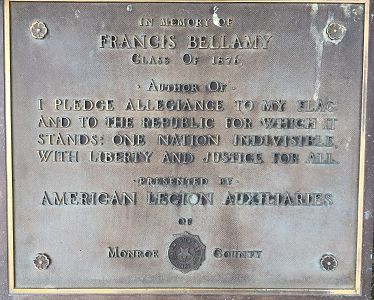 |
© 2021-2022 Morris A. Pierce